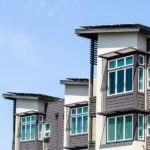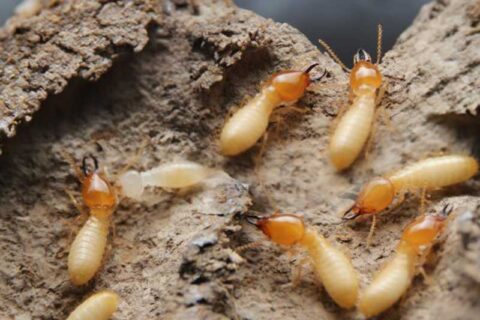California Termites
There’s a lot to love about California, including miles of gorgeous coastline, plenty of National parks, and truly beautiful weather. Unfortunately, people are not the only species that enjoy the state. Termites love it too! They like it so much, in fact, that there are five different species who call the Golden State home. Let’s take a closer look at these pests, their life cycles, and habits, how to identify them, and how to keep them from damaging your California home.
Western subterranean termites often infest homes in California.
They’re particularly troublesome in the urban areas of Fresno, Salinas, Bakersfield, Santa Maria, Los Angeles, Pasadena, Riverside, Orange County, San Bernadino, Long Beach, Santa Ana, and San Diego, and have been found as far north as Sacramento. They’re highly destructive, not only to homes but also to timber, making them a big problem for the timber industry. They cause millions of dollars of damage each year, and it’s been estimated that one in five homes in areas with high termite activity will be infested by these insects.
Western subterranean termites are skilled builders, and they have an elaborate social system with several different castes. The queen has an enormous body and is a prolific egg layer. She can live for more than 25 years, laying 2,000 eggs or more a day. She and the king live in a central chamber, producing offspring and being tended by workers. If you have termites on your property, you’re unlikely to see the well-protected queen. If you disturb a termite colony, you’re likely to see worker termites, the largest caste in the termite colony. They’re the termites that do all the damage as they gather food, construct tunnels, repair and enlarge the colony’s nest, groom each other, and feed the soldiers, king, and queen. Workers are also responsible for caring for young nymph termites as they mature. Western subterranean worker termites are soft-bodied and translucent, with a creamy color. They’re tiny, only about 1/8th of an inch long, and have no wings. Soldier termites have large, orange, rectangular heads with mandibulate pinchers they use to crush marauding ants and defend their colony. When a mud tube or damaged piece of timber is opened, soldier termites rush out to guard the opening while worker termites do the necessary repairs.
If you find termite wings on your property, they have been shed by alates, young reproductive termites. Western subterranean alates are about 3/8th of an inch long, with a dark brown body and brownish grey wings. In California, Western subterranean termites typically swarm in the spring. Alates, the young kings and queens of future colonies, leave their existing colonies in swarms of thousands to find mates and establish new homes. Once they’ve paired off and found a suitable spot, they settle in to begin the reproductive cycle anew.
Subterranean termites live underground, below the frost line, and above the water table. They construct a central colony with tunnels that radiate out within a 100-yard radius. Because they need high humidity to survive, they travel in mud tubes that protect them from the sun, predators, and dehydration. Seeing these tubes is often the first indication to a homeowner that Western subterranean termites have infested the house. If you find these termites on your property, do not disturb them, as this will cause them to seek a more secretive spot on your property. Instead, call in a professional to handle the problem.
Desert subterranean termites are another common California species.
As the name suggests, they live in desert areas. They’re less dependent on decay and moisture than other species of subterranean termites, and will often attack dry, sound wood. If you’ve got Desert subterranean termites in your building, you may notice drop tubes coming from the ceiling rafters. You may also see holes in the sheetrock or plasterboard plugged with termite droppings. Their swarmers are about 3/8th of an inch long, but the workers only need about 1/32nd of an inch to get into a piece of wood. Desert subterranean swarmers have pale yellowish-brown bodies and translucent wings, and they tend to swarm at night, during the rainy season. Desert subterranean soldiers have rectangular heads, long, powerful, pointed haws, and bodies that are flat and wide. A well-developed colony of this type of termite will often have secondary reproductive termites and a population of about 300,000 in total. They can forage in dry material and expand their foraging to about an acre of territory.
Arid-land subterranean termites are by far the most destructive termite in Arizona.
Because they are commonly found from the Pacific Coast to Indiana, though, they also live in California. In elevations below 4,000 feet, they swarm between January and March. Above that, they typically swarm in June and July. Arid land subterranean swarmers are about 1/3rd of an inch long with wings, with dark brown to black bodies and white wings. The soldiers are ¼ of an inch long, and their jaws are almost straight. In addition to buildings, these termites attack creosote and greasewood bushes.
Western drywood termites are found in southwestern states and all the way up to Sacramento.
They are found in greater numbers along with the coastal areas, however. This species causes most of the drywood termite damage in California and is often transported in furniture and timber. Drywood swarmers are about ½ an inch long including wings. They’ve’ got orange-brown heads, dark brown abdomens, and wings with three dark veins in the front portion. The soldiers have sloping foreheads with heads that are orange to reddish-brown, mandibles with an unequal number of teeth, and antennae with a greatly enlarged, club-like third segment. Colony development for these insects is slow, but multiple colonies often cause severe structural damage. Drywood termites create tunnels and chambers in the wood they infest. If you’ve got a Western drywood termite infestation, you may notice shed wings, piles of pellets, and surface blisters on wood.
Pacific dampwood termites make up the most significant dampwood termite species in the United States.
They’re typically found in cool, humid coastal areas. They swarm throughout the year, but most commonly from August to October, on warm, humid evenings. Swarmers can be as large as one inch in length, with light to medium brown bodies and dark brown wings, and they’re strongly drawn to light. Dampwood soldiers have large heads with long, black-toothed mandibles. Their anterior is black to a dark reddish-brown, and the abdomen and thorax are a light caramel color. These are the largest termites in the country, and the soldiers can reach 5/8th to ¾ of an inch. If you’ve got a Pacific dampwood termite infestation, you may not know it, because they tunnel inside the wood and leave their fecal pellets inside the tunnels.
At MightyMite Termite Services, we’re experts in controlling all types of termites in California. We perform termite inspections to ensure that your home is free of termites and work hard to help you keep it that way, using treatments that are naturally derived and have a low impact on the environment. We diagnose and treat infestations with the most effective methods and unmatched warranties, solving your termite problems the first time, with an industry-best “no call-back rate.” That, combined with our experience, technology, and highly trained professional staff, makes us the leading extermination company in the Bay Area. We understand that your home is your most important investment, so we work hard to provide excellent service, utilizing best practices to solve our customers’ termite problems in Northern California. For more information, call us today at 408.335.7053, email Info@mightymitetermite.com, or contact us through our website.









